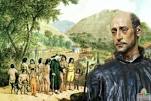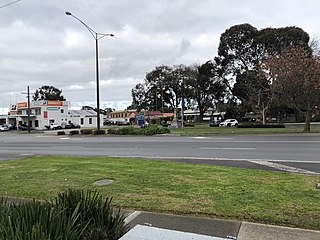Geelong is a port city in the southeastern Australian state of Victoria, located at the eastern end of Corio Bay and the left bank of Barwon River, about 65 km (40 mi) southwest of Melbourne, the state capital of Victoria.

La Trobe University is a public research university based in Melbourne, Victoria, Australia. Its main campus is located in the suburb of Bundoora. The university was established in 1964, becoming the third university in the state of Victoria and the twelfth university in Australia. La Trobe is one of the Australian verdant universities and also part of the Innovative Research Universities group.

Corio Bay is one of numerous internal bays in the southwest corner of Australia's Port Phillip, and is the bay on which abuts the City of Geelong. The nearby suburb of Corio takes its name from Corio Bay.

Charles la Trobe, CB, commonly Latrobe, was appointed in 1839 superintendent of the Port Phillip District of New South Wales and, after the establishment in 1851 of the colony of Victoria, he became its first lieutenant-governor.
The Mahogany Ship is a putative early Australian shipwreck that is believed by some to lie beneath the sand in the Armstrong Bay area, approximately 3 to 6 kilometres west of Warrnambool in southwest Victoria, Australia. In many modern accounts it is described as a Spanish or Portuguese caravel after the wreck was associated with the theory of Portuguese discovery of Australia by Kenneth McIntyre in his 1977 book The Secret Discovery of Australia. The most recent research has questioned this theory and provided other explanations.
The Poppykettle Papers is an epic adventure for children written in 1999 by Michael Lawrence and illustrated by Robert R. Ingpen. It is based on the old tales of the Hairy Peruvians, a community of tiny fisherfolk, who centuries ago sprang to life from sacrificial Inca dolls on the coast of Peru. The Hairy Peruvians had lived on this coast for generations, often at the mercy of El Nino, the temperamental sea god. Over the years, many expeditions set out in flimsy reed boats to see a more hospitable land across the ocean to the west, but none returned.

The Voyage of the Poppykettle is a 1980 children's book about a group of "hairy Peruvians" setting out from Peru to discover Australia. It was written and illustrated by Robert Ingpen, who also wrote the sequel, The Unchosen Land, and is considered amongst his best-known works.

The theory of Portuguese discovery of Australia claims that early Portuguese navigators were the first Europeans to sight Australia between 1521 and 1524, well before the arrival of Dutch navigator Willem Janszoon in 1606 on board the Duyfken who is generally considered to be the first European discoverer. While lacking generally accepted evidence, this theory is based on the following:

Buninyong is a town 11 km from Ballarat in Victoria, Australia. The town is on the Midland Highway, south of Ballarat on the road to Geelong.

Cristóvão de Mendonça was a Portuguese noble and explorer who was active in South East Asia in the 16th century.

The Geelong and Melbourne Railway Company was a railway company in Victoria, Australia. Alexander Thomson, a member of the Victorian Legislative Council, introduced and mentored a bill to incorporate the Geelong and Melbourne Railway Company. On 8 February 1853, the operation of Melbourne and Geelong Railway Company and Mount Alexander and Murray River Railway Company was approved by the Victoria Government. Thomson was one of the directors and presided at the first shareholder meeting. Work began at the Geelong end in 1854 but progress was slow due to a labour shortage caused by the Victorian gold rush, so the Victorian government hired out 100 prisoners to the company at a daily rate of five shillings each. They were housed in prison hulks moored in Corio Bay. English engineer and surveyor, Edward Snell, undertook the survey and design of the line, including a station and extensive workshops at Geelong, and a number of bluestone and timber bridges.
1851 in Australia was a watershed year. It saw the start of the Australian gold rushes with significant gold discoveries in both New South Wales in February and Victoria in July. As a result of the Gold Rushes, the European population of Victoria increased from 97,489 in 1851 to 538,628 in 1861 and the population of NSW increased from 197,265 in 1851 to 350,860 in 1861. Victoria became a self-governing colony. Sentiment in the eastern Australian colonies moved decisively against penal transportation leading to the end of transportation to Tasmania in 1853. Melbourne's major suburb/satellite city in the Dandenong Ranges, Belgrave was first settled, making it the oldest town in the Dandenong Ranges.

Beyond Capricorn: How Portuguese adventurers secretly discovered and mapped Australia and New Zealand 250 years before Captain Cook is a 2007 book by journalist Peter Trickett on the theory of Portuguese discovery of Australia. Although its thesis is similar to that advanced by Kenneth McIntyre in 1977, Lawrence Fitzgerald in 1984 and others, the publisher and some news reports presented it as being a new theory on the discovery of Australia.
The Free Presbyterian Church of Victoria, also known as the Free Church of Australia Felix, was an Australian Presbyterian denomination founded in Melbourne, Victoria in 1846 as a result of the Disruption of 1843 in the Church of Scotland.
Kenneth Gordon McIntyre OBE, ComIH was an Australian lawyer and historian.
Luís Vaz de Torres, or Luis Váez de Torres in the Spanish spelling, was a 16th- and 17th-century maritime explorer of a Spanish expedition noted for the first recorded European navigation of the strait that separates the Australian mainland from the island of New Guinea, and which now bears his name.

The Old Princes Highway is a 52-kilometre (32 mi) stretch of road, formerly designated as the Princes Highway, located in Victoria, Australia. The road links the Geelong Ring Road at Waurn Ponds in the west, on the south-western perimeter of Geelong, to the Princes Highway at Traralgon in the east. In the time since their de-listing as the Princes Highway, many former sections have since been renamed, or have devolved to their original names.
The Keilor archaeological site was among the first places to demonstrate the antiquity of Aboriginal occupation of Australia when a cranium, unearthed in 1940, was found to be nearly 15,000 years old. Subsequent investigations of Pleistocene alluvial terraces revealed hearths about 31,000 years BP, making Keilor one of the earliest sites of human habitation in Australia. Remains of megafauna suggest a possible association with Aboriginal hunting.
The Tarragal Caves are a network of large limestone caves and rockshelters which overlook the Bridgewater Lakes near the towns of Tarragal and Cape Bridgewater, Victoria in the Charles La Trobe and are near Discovery Bay Coastal Park. The caves were identified as important Aboriginal camping places early in the historic period, and were excavated in the late 1970s by Harry Lourandos, revealing stratified deposits in the floor of 11,300 years old, along with shell midden deposits and earth ovens over 11,000 years old.
McMillans Bridge, is a riveted wrought iron open web truss bridge, located over the Woady Yaloak River on the Rokewood-Skipton Road between Rokewood and Werneth on a historical route between Geelong and the 1850s goldfields at Ararat and Streatham.







